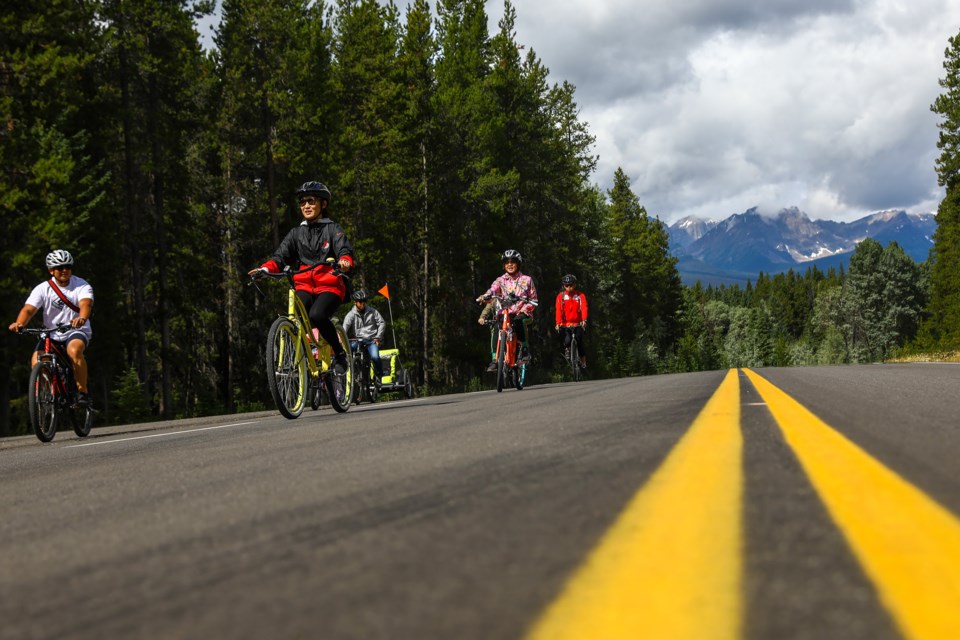BANFF – The Bow Valley Parkway is reopening to public vehicles on Nov. 15 for the first time since the COVID-19 pandemic struck.
Parks Canada officials say visitation will be monitored closely, adding that limiting access will be considered if Johnston Canyon gets too busy for people to safely physically distance this winter.
“We may look at putting in other measures to help Canadians and Albertans continue to be safe this winter,” said Daniella Rubeling, visitor experience manager for Banff National Park.
“We’re looking at potentially managing some of the access during peak times, like long weekends or the holiday season, so at this point we’re taking an adaptive management approach to look at use.”
The Bow Valley Parkway is closed overnight seasonally each spring to give wildlife such as denning wolves space and security at a critical time of year.
However, Parks Canada shut down the parkway to all public vehicles on March 25 from the Fireside day-use area to Castle Junction in response to the COVID-19 pandemic.
With the parkway reopening on Nov. 15, visitors are strongly encouraged to wear a mask while hiking along the Johnston Canyon trail.
“There are narrow sections and it is relatively popular, so it may be difficult to maintain that two-metre distance,” Rubeling said.
“Wearing masks is really becoming normalized and we encourage people to wear masks out on the trails.”
Parks Canada looked at several options for the parkway, including keeping it closed for winter, but decided to open it to support the local business community.
“It’s also a very important area for a lot of our guided business licence holders … this is a piece of the consideration that went into reopening the parkway,” Rubeling said.
“But if those visitation numbers start to increase, to supersede what we saw this summer, that’s where we will be looking at other ways to manage access.”
The southern Alberta chapter of the Canadian Parks and Wilderness Society (CPAWS) conducted an online survey to get’ thoughts from visitors on the vehicle closure of the eastern portion of the parkway.
Preliminary results from the 3,120 survey responses showed that 76 per cent of respondents were road biking and an additional 16 per cent were on some kind of bike – e-bike, town bike, or mountain bike.
Sarah Elmeligi, who works as a consultant for CPAWS on national park issues, said that 87 per cent of respondents were extremely satisfied with their recreation experience.
She said, overall, respondents strongly agreed that their recreational experience was better because of the closure, and that the closure should continue in some form beyond 2020.
“Respondents strongly supported continuing this closure next summer,” Elmeligi said.
“When we asked people to compare recreating on the parkway this summer to previous summers, respondents consistently had more fun with friends/family, felt more connected to the natural beauty of the parkway, felt safer, and enjoyed their experience more this year than in previous years.”
Elmeligi will be writing a final report based on more detailed survey results, which will be released toward the end of the month.
“That short final report will have much more detailed information and recommendations for moving forward,” she said.
Parks Canada hasn’t made a decision on whether or not to close the parkway to public vehicle traffic again next year.
“We’ve received many positive comments from visitors and residents alike requesting more cycling opportunities,” Rubeling said.
“We are looking at opportunities and options based on successes from existing cycling options like the Legacy Trail, as well as opportunities that came out of the COVID pandemic.”
Meanwhile, the lower viewpoint to the 30-metre high Upper Falls at Johnston Canyon remains off limits until further notice due to damage to a section of the canyon-clinging catwalks.
In early October, a routine engineering inspection discovered that a section of catwalk located on the trail had structural damage to its footings, making it unsafe.
“It’s not accessible and it’s still under investigation by our assets and infrastructure folks,” Rubeling said, noting people can still hike to the upper viewpoint of the upper falls. “They’re looking at some of the next steps there, and that still has not been determined.”



